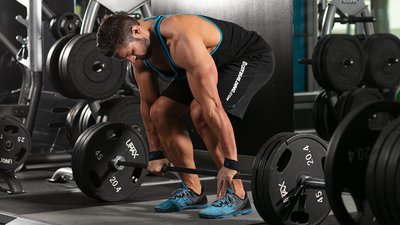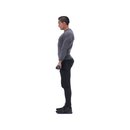Training back is probably one of the most complicated yet one of the most rewarding bodybuilding training experiences. Complicated because the back is a complicated area made harder because you can't see what you're training.
Yet, since the back is such a big area, full development is essential. For me personally, Arnold's back always impressed me, especially his lower back when he was in his best shape. It was that aspect of his back I liked the most. Of course, there are a lot of great backs out there and everybody has there favorite. Imagine how your favorite would look if his back was, say, only 80% as developed as it is now? What a difference!
The back is made up of the following main muscles: the trapezius or traps, the latissimus dorsi or lats, the middle back or rhomboids and the spinal erectors. Many people, myself included, train traps with deltoids. The main exercises for the traps are shrugs and upright rows.
Refer to my "Devastating Delts" article to see how to work traps in with your shoulder routine. Actually, the back and shoulders interact in more ways than one, the rear delts are a critical part of any back pose and, at least to my mind, must be developed fully or your back just doesn't look as good as it could.
Remember, training back is hard work or at least it better be if you want good results.
Also stretch your back out between each set. 3 working sets of 6 to 8 reps, failing at that rep range. Dead-lifts are a core exercise that should always be done - they not only affect the back but the whole body. They are second only to Squats in terms of exercises that affect the whole body, and to be honest, they are a very close second.

BodyFit
$6.99/month- 2,500+ expert-created single workouts
- 3,500+ how-to exercise videos
- Detailed workout instruction
- Step-by-step workout tips
- Training at gym or at home
- Access to Workout Plans
- Access to Bodyfit App
- Store Discounts
Already have a Bodybuilding.com account with BodyFit? Sign In

What comes with BodyFit?

- Instructional Videos
Don't risk doing a workout improperly! Avoid injury and keep your form in check with in-depth instructional videos.

- How-to Images
View our enormous library of workout photos and see exactly how each exercise should be done before you give it a shot.

- Step-by-Step Instructions
Quickly read through our step-by-step directions to ensure you're doing each workout correctly the first time, every time.
4 working sets of 8 reps, 2 sets to the front and 2 sets to the rear - your back should face the machine on these, that's what I mean by "to the rear". You can also vary your grip width, doing so tends to give a different feel to the exercise. Do these to failure.
I don't do a lot of intensity techniques when training back, other than some rest pause reps now and then. It's too easy to lose the feel in your back and begin to feel it in your biceps. Also, your biceps and forearms fatigue and give out if you try extending your sets to long, taking the stress away from your back.
At least, that's what happens when I train. You do, however, want to train back heavy to a point of failure. No working set should be easy, nor should you ever be able to continue past the suggested reps.

BodyFit
$6.99/month- 2,500+ expert-created single workouts
- 3,500+ how-to exercise videos
- Detailed workout instruction
- Step-by-step workout tips
- Training at gym or at home
- Access to Workout Plans
- Access to Bodyfit App
- Store Discounts
Already have a Bodybuilding.com account with BodyFit? Sign In

What comes with BodyFit?

- Instructional Videos
Don't risk doing a workout improperly! Avoid injury and keep your form in check with in-depth instructional videos.

- How-to Images
View our enormous library of workout photos and see exactly how each exercise should be done before you give it a shot.

- Step-by-Step Instructions
Quickly read through our step-by-step directions to ensure you're doing each workout correctly the first time, every time.
Weighted if possible - 4 sets as above, meaning 2 to the front and 2 to the rear. As above, work to failure. As always, do your reps in good form - this is especially true when training back - if in doubt as to your form or as to exact exercise performance - ask someone to guide you.
I can tell you from experience, I didn't do that on High Pulls - this was in 1996, and to this day I still have elbow problems that limits my training. When that first happened, I couldn't pick up a piece of paper without being in a lot of pain. The point: learn how to do it right.
As most advanced trainers know, including a "rowing" exercise in your routine such as bent rows, cable rows or t-bar rows builds back thickness. Width comes from the pull down and chin up movements.
For you new trainers out there, when designing a back routine, always include 1-2 rowing and 1-2 pulling movements to promote full development. Include a direct trap movement such as shrugs or upright rows - on deltoid day or, if you want, try it on back day - and dead-lifts, which target the lower back but work the whole body to various degrees and you have a good back routine.
I don't know if people design their own routines any more in this day and age of personal trainers and all that, but I personally recommend you do. I learned how to design good routines by doing a lot of research into the body parts being worked, what there functions were and what exercises worked best to build the most mass in those body parts. I've been known to spend days just researching a couple of exercises before including them in my routine.
Conclusion
A full understanding, or at least the ability to have access to such an understanding, is necessary in order to take full advantage of the exercises you're using. Not to take anything away from personal trainers, but it's a good thing to be able to think for yourself when creating the body of your dreams.
To go back to the routines for a moment and to what I said about intensity techniques, it's a good idea to extend at least some of your working sets with either rest-pause reps or forced reps.
If you can keep your arms from giving out first, experiment with other techniques to see what works. These could include: drop sets, super sets, or static hold reps. Static hold reps are where you would hold the weight in the fully contracted position for a 5-10 count.
Using cable rows as an example, you would start your rep, hold the bar at your waist for a 5-10 count then complete the rep - this is one rep. Experimenting like this is one way of learning about your body and learning what works well for you and what doesn't.
Utilize the two routines above, interchange them in your back training, substitute other movements for variety and work the exercises hard but in good form - add good nutrition and supplements to the mix and you have the makings of a great back!




